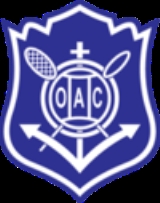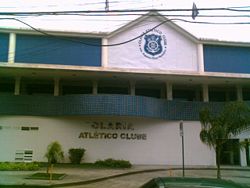
Olaria Atlético Clube
Encyclopedia
Olaria Atlético Clube, or Olaria as it is usually called, is a traditional Brazilian football team from Olaria neighborhood, Rio de Janeiro
, in Rio de Janeiro state
, founded on July 1, 1915. The club name means brick factory, and is also the name of the club's neighborhood.
Olaria is one of the small clubs from Rio de Janeiro that have managed to remain active in the shade of the four big ones (Flamengo
, Vasco da Gama
, Botafogo
and Fluminense
).
In 1974, Olaria competed in the Campeonato Brasileiro First Division
, finishing in the 28th position.
In 1981, Olaria won the Campeonato Brasileiro Third Division
, called Taça de Bronze (Bronze Cup). In the final, the club beat Santo Amaro of Pernambuco
state. In 1983, the club won the Campeonato Carioca Second Division
, being promoted to the following year's first division
. In 1999, an enterprise called Sport News assumed the club's football section for a short time period.
In 2000, Olaria was in the White Module (which was the equivalent of a third level) of Copa João Havelange
. The club was eliminated in the first stage. In 2003, the club competed again in the Campeonato Brasileiro Third Division. Olaria was eliminated in the third stage by Cabofriense
.

.
(1958–61) Garrincha
(1972) Romário
(started his career in 1983, playing for Olaria youth squad. ) Brazil Ronan
Brazil Ronan
 Mehmet Aurélio (2001)
Mehmet Aurélio (2001)
, button football
, football society, karate
, judo
, basketball
and swimming
.
Rio de Janeiro
Rio de Janeiro , commonly referred to simply as Rio, is the capital city of the State of Rio de Janeiro, the second largest city of Brazil, and the third largest metropolitan area and agglomeration in South America, boasting approximately 6.3 million people within the city proper, making it the 6th...
, in Rio de Janeiro state
Rio de Janeiro (state)
Rio de Janeiro is one of the 27 states of Brazil.Rio de Janeiro has the second largest economy of Brazil behind only São Paulo state.The state of Rio de Janeiro is located within the Brazilian geopolitical region classified as the Southeast...
, founded on July 1, 1915. The club name means brick factory, and is also the name of the club's neighborhood.
Olaria is one of the small clubs from Rio de Janeiro that have managed to remain active in the shade of the four big ones (Flamengo
Clube de Regatas do Flamengo
Clube de Regatas do Flamengo , also known as Flamengo and familiarly as Mengão, is a Brazilian sports club based in the Flamengo bairro, Zona Sul, Rio de Janeiro, best known for its professional football team...
, Vasco da Gama
Club de Regatas Vasco da Gama
Club de Regatas Vasco da Gama |Rowing Club]]), usually known as Vasco da Gama or simply Vasco, is a famous and traditional Brazilian multisports club from Rio de Janeiro in Brazil, founded on August 21, 1898...
, Botafogo
Botafogo de Futebol e Regatas
Botafogo de Futebol e Regatas , also known as Botafogo and familiarly as Estrela Solitária, is a Brazilian sports club based in Botafogo, neighborhood of Rio de Janeiro, best known for its football team. They play in the Campeonato Carioca, Rio de Janeiro's state league, and the Campeonato...
and Fluminense
Fluminense Football Club
Fluminense Football Club is a sports club based in Rio de Janeiro, Brazil. Founded in the beginning of the 20th century as a single-sport institution, Fluminense is today an umbrella organization for several teams in more than 16 different sport activities. The most popular endeavor of Fluminense,...
).
History
On July 1, 1915, the club was founded as Japonês Futebol Clube (Japanese Football Club, in English). The club was later in that year renamed to Olaria Atlético Clube, by Calorino Martins Arantes, who was a club director, to attract more supporters.In 1974, Olaria competed in the Campeonato Brasileiro First Division
Campeonato Brasileiro Série A
The Campeonato Brasileiro de Clubes da Série A , popularly known as the Brasileirão , is a professional football league at the top of the Brazilian football league system held annually since 1959. Contested by twenty clubs, it operates a system of promotion and relegation with the Série B...
, finishing in the 28th position.
In 1981, Olaria won the Campeonato Brasileiro Third Division
Campeonato Brasileiro Série C
The Campeonato Brasileiro Série C is the third division of Brazilian football.Unlike the first and second divisions, the Série C is not played in a double round robin system, arguably because many participating teams lack the financial conditions to travel long distances...
, called Taça de Bronze (Bronze Cup). In the final, the club beat Santo Amaro of Pernambuco
Pernambuco
Pernambuco is a state of Brazil, located in the Northeast region of the country. To the north are the states of Paraíba and Ceará, to the west is Piauí, to the south are Alagoas and Bahia, and to the east is the Atlantic Ocean. There are about of beaches, some of the most beautiful in the...
state. In 1983, the club won the Campeonato Carioca Second Division
Campeonato Carioca (lower levels)
The Campeonato Carioca lower levels are the football tournaments for the Rio de Janeiro clubs that do not play in the Campeonato Carioca First Division. The competitions are organized by the Rio de Janeiro State Football Federation...
, being promoted to the following year's first division
Campeonato Carioca
The Campeonato Carioca, also known as Campeonato Estadual do Rio de Janeiro, is the football league of the state of Rio de Janeiro, Brazil and is one of the most prestigious national football tournaments...
. In 1999, an enterprise called Sport News assumed the club's football section for a short time period.
In 2000, Olaria was in the White Module (which was the equivalent of a third level) of Copa João Havelange
Copa João Havelange
Copa João Havelange was the 30th season of the Campeonato Brasileiro, the top-level of professional football in Brazil. Due to legal complications, the championship was organized by Clube dos 13 instead of CBF, and was contested by 116 teams divided in modules, equivalent to their division -...
. The club was eliminated in the first stage. In 2003, the club competed again in the Campeonato Brasileiro Third Division. Olaria was eliminated in the third stage by Cabofriense
Associação Desportiva Cabofriense
Associação Desportiva Cabofriense, or Cabofriense as they are usually called, is a Brazilian football team from Cabo Frio in Rio de Janeiro, founded on January 2, 1997.Home stadium is the Correão stadium, capacity 12,000.-History:...
.

Achievements
- Brazilian Third DivisionCampeonato Brasileiro Série CThe Campeonato Brasileiro Série C is the third division of Brazilian football.Unlike the first and second divisions, the Série C is not played in a double round robin system, arguably because many participating teams lack the financial conditions to travel long distances...
(Taça de Bronze): 1
-
- 1981
- Campeonato Carioca Second LevelCampeonato Carioca (lower levels)The Campeonato Carioca lower levels are the football tournaments for the Rio de Janeiro clubs that do not play in the Campeonato Carioca First Division. The competitions are organized by the Rio de Janeiro State Football Federation...
: 3
-
- 1931, 1980, 1983
Stadium
Home stadium is the Rua Bariri stadium, capacity 11,000. This stadium is often rented to the big clubs (notably Flamengo) when they are unable to play at the MaracanãEstádio do Maracanã
The Estádio do Maracanã , officially Estádio Jornalista Mário Filho, is an open-air stadium in Rio de Janeiro, Brazil. Owned by the Rio de Janeiro State Government, it is named after the Maracanã neighbourhood in Rio de Janeiro. It was opened in 1950 to host the FIFA World Cup, and in the final...
.
Noted players
Antônio LopesAntônio Lopes
Antônio Lopes dos Santos, usually known as Antônio Lopes is a Brazilian football manager and former footballer....
(1958–61) Garrincha
Garrincha
Manuel Francisco dos Santos , known by the nickname "Garrincha" , was an association football right winger and forward who helped the Brazil national team win the World Cups of 1958 and 1962. He played the majority of his professional career for Brazilian club Botafogo.The word garrincha itself...
(1972) Romário
Romário
Romário de Souza Faria , better known simply as Romário , is a former footballer who played striker,manager and current politician where is currently running for a mayor like position in his hometown...
(started his career in 1983, playing for Olaria youth squad. )
 Brazil Ronan
Brazil RonanRonan Carolino Falcão
Ronan Carolino Falcão , simply known as Ronan, is a naturalized Equatoguinean football defender, who plays for Mes Rafsanjan in the Azadegan League .-Early career:...
 Mehmet Aurélio (2001)
Mehmet Aurélio (2001)Anthem
The club's official anthem was composed by Lamartine Babo, who composed the anthems of the Rio de Janeiro big clubs.Other sports
Besides football, Olaria also has other sports sections, such as futsalFutsal
Futsal is a variant of association football that is played on a smaller pitch and mainly played indoors. Its name is a portmanteau of the Portuguese futebol de salão and the Spanish fútbol de salón , which can be translated as "hall football" or "indoor football"...
, button football
Button football
Button football is a football simulation game played on a table-top using concave "disks" or "buttons" as players. Board dimensions, markings, and rules of play are modeled to simulate standard football...
, football society, karate
Karate
is a martial art developed in the Ryukyu Islands in what is now Okinawa, Japan. It was developed from indigenous fighting methods called and Chinese kenpō. Karate is a striking art using punching, kicking, knee and elbow strikes, and open-handed techniques such as knife-hands. Grappling, locks,...
, judo
Judo
is a modern martial art and combat sport created in Japan in 1882 by Jigoro Kano. Its most prominent feature is its competitive element, where the object is to either throw or takedown one's opponent to the ground, immobilize or otherwise subdue one's opponent with a grappling maneuver, or force an...
, basketball
Basketball
Basketball is a team sport in which two teams of five players try to score points by throwing or "shooting" a ball through the top of a basketball hoop while following a set of rules...
and swimming
Swimming (sport)
Swimming is a sport governed by the Fédération Internationale de Natation .-History: Competitive swimming in Europe began around 1800 BCE, mostly in the form of the freestyle. In 1873 Steve Bowyer introduced the trudgen to Western swimming competitions, after copying the front crawl used by Native...
.

